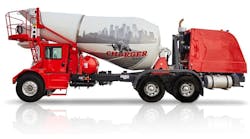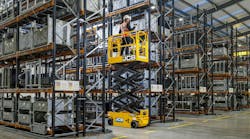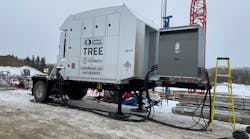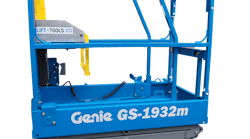The lure of an informative and fun networking event and Arizona sunshine enticed eight North American telehandler manufacturers to participate in the third annual Lift and Access Equipment Showcase. Of the 18 products listed in the Lift and Access Equipment Guide in the 6,000- to 7,000-pound capacity, 41- to 44-foot boom length class, 13 machines made it to the Equipment Showcase.
Units present included the Cat TL642, Gehl DL7-44, Genie GTH-644, JCB 507-42, JLG G6-42A and G6-42P, Lull 644E-42, SkyTrak 6042, Manitou MT 6642, Mustang 642, Pettibone 744, Skyjack VR-642D, and Skyjack Zoom Boom ZB6042.
As the telehandler market evolves, so do consumer buying habits. Earlier this decade, 6,000- to 7,000-pound pick-and-place telehandlers with 41- to 44-foot boom lengths were the most popular on the market. As jobsite needs change and new product segments are introduced, the reins have transferred to larger machines with longer booms in recent years. The growth of compact telehandlers also has encumbered its market share.
However, the 6,000-pound pick-and-place telehandlers continue to hold their own as the most popular machines found in rental equipment fleets and on general construction projects. The Lift and Access Equipment Showcase in 2008 celebrated the long-lasting success of this telehandler category. The well-established product range offers end users the capacity required to lift many jobsite materials up to three stories and enough forward reach to spot loads as far as 35 feet in front of the machine. To meet different application needs, manufacturers provide a variety of attachments, including standard, side-tilt and 90- or 180-degree swing carriages in various sizes, masts, various sizes of buckets, work platforms, sheet material adapters, and fork-mounted lifting hooks.
This staple class size has seen some new introductions in the past few years. Most recently, the Cat TL642 and New Holland M427 were introduced in early 2007, the Case TX742 was launched in January 2008, and JCB debuted the Loadall 507-42 at ConExpo 2008. Additionally, the Pettibone 744 received a 1,000-pound capacity increase in 2008, which resulted in a new model name to reflect this change. Genie also has reported it will be making updates to its GTH-644 model in the near future.
During the Equipment Showcase, Lift and Access staff members put the telehandlers through their paces, measuring lift height and forward reach, as well as speed of the lifting and lowering capabilities, gross vehicle weight, and even the number of decibels put out by the machine. In addition to gathering new data above and beyond manufacturers’ published specifications, the Lift and Access team verified several of the manufacturers’ previously published specs.
Engine Location
Engine placement is one subtle design difference that sets telehandlers in the same size class apart. Telehandler manufacturers are divided into two camps: Companies that prefer side-mounted engines located in “pods” on the side of the machine, or those that like engines centrally or rear mounted within the frame.
Looking back in telehandler history, the earliest known telescopic material handler as the Pettibone Extendo, which was produced in about 1969. The Extendo and other early telehandlers were designed with the engine mounted in the frame, which was driven largely by the engine, transmission, and driveline technology available at that time. Most of these components had to be off-the-shelf items, so OEMs turned to readily available, tried-and-true tractor technology, which drove engine placement and boom-pivot locations. The boom-pivot point was mounted either high above or behind the engine.
In the following years, the European market demanded more compact and versatile machines. All-around visibility concerns drove them to lower the boom-pivot point, which allowed for better visibility on the right side of the unit when the boom was fully lowered. Lowering the boom mandated a revision to the layout and included moving the engine to a location on the side between the wheels. Merlo, Caterpillar, and Manitou introduced machines in the late 1980s and early 1990s with side-mounted engine designs, but the over-the-boom visibility and the perceived service access advantages came at a cost premium if a hydrodynamic drive was used. But according to Dana Spicer, a leading supplier of driveline products to the telehandler industry, the volumes produced today make the cost more manageable.
The first side-mounted engine telehandler sold in North America in large quantities was the Caterpillar A Series, which featured a parallel side-engine layout with hydrodynamic transmission. Dana supplied the complete drivetrain, which included the T12000 transmission, transfer case, and axles.
Of the 6,000- to 7,000-pound capacity pick-and-place telehandlers at the 2008 Equipment Showcase, six machines featured side-mounted engines and seven had in-frame engines. Note that currently the Genie GTH644 telehandler has a rear-mounted engine. After some future planned design updates, the company said the machine will feature a side-mounted engine design.
Each design has pros and cons. Side-mounted engines, such as those on the JLG-brand telehandlers and the JCB Loadall machine, are located under large swing-up hoods that are typically made of fiberglass or ABS plastic. They are easy to secure under lock and key, and fluid checkpoints, filters, and the battery are all handy.
However, some service points—the starter, in particular—are located on the back side of the engine and require technicians to lie on their backs and crawl under the engine to reach them. A muddy jobsite makes this task even less appealing.
The in-frame engine mounted in the rear of the frame, such as with the SkyTrak and current Genie telehandler, is the most traditional location for engine placement. More recently introduced models, including the Zoom Boom, Skyjack VR, Pettibone, Manitou, and Mustang machines, place the engines closer to the middle of the frame. Although service points on the rear engine units are quite good, there are some access limitations when compared to the improved access offered by the newer mid-engine designs.
Telehandler manufacturers that adhere to the in-frame engine design say it offers unique advantages, such as no additional cost and maintenance associated with the required transfer box between the transmission and driveline. They also say the absence of the pod improves right side visibility—especially when the boom is elevated in a carrying position. Additionally, these OEMs point out the pod engine could limit maneuverability when attempting to crab up next to a post or beam.
Although not an operator issue, engineers must handle maintaining the center of gravity along the centerline of the machine. When an engine is mounted on the side, significant counterweight must be added.
Engine Types
Tier 3 engine integration continues on telehandlers with horsepower ratings between 50 and 100. More than half of the machines at the Equipment Showcase have made the switch, while the rest plan to incorporate the updated engines in the near future. These machines rely on Cat, Deere, Perkins, JCB, and Cummins diesel engines for power. Of these engines, Cummins and Deere are the most popular.
Two of the five Showcase telehandlers utilized Tier 3 Cummins engines. Pettibone features the 110-hp Cummins QSB4.5 turbocharged diesel. The Cummins QSB4.5 achieves Tier 3 compliance with in-cylinder technology. It shares technology with the B Series, including charge air cooling and turbocharging for strong performance. Power ratings range from 110 to 150 hp.
The QSB4.5 has improved cold-start capabilities and is 5 to 9 decibels quieter in operation than its predecessor. It runs as quietly at full load as the previous QSB did with no load. Prior to the Skyjack purchase of the VR Series, these telehandlers received Tier 3 updates. The VR-642D is powered by the 110-hp turbo Cummins QSB3.3.
The Cummins QSB3.3 delivers between 80 and 110 hp in a package that is 30 percent smaller and lighter than the average 4- to 4.5-liter engine. It meets Tier 3 emissions requirements without exhaust gas recirculation and operates safely on fuel with a high sulfur content. According to Cummins, the QSB3.3 combines the proven reliability and minimal maintenance of the B3.3 model with performance-enhancing features like the Cummins Quantum System electronic controls and a High Pressure Common Rail (HPCR) fuel system.
Other models with Cummins engines include the Zoom Boom ZB6042, the Lull 644E-42, and the SkyTrak 6042. Zoom Boom is currently using the Tier 2 99-hp Cummins 4BT4.5 with plans to transition to the Tier 3 QSB4.5 model in 2009. Lull and SkyTrak currently use the 99-hp Cummins B4.5T.
Six Showcase machines employed the Deere 4045 engine. This 4.5L, four-cylinder engine ranges from 85 to 140 hp. The Tier 3-compliant 4045 engine model features a two-valve cylinder head, HPCR, full authority electronic engine controls, and a fixed geometry turbocharger. For enhanced engine performance, the unit has a new power bulge feature, increased low-speed torque, new higher-peak torque speed, faster torque rise, lower-rated speeds available for reduced noise, and improved fuel economy.
Gehl is using the Tier 3, 115-hp Deere 4045T. Manitou and Mustang feature the Tier 2-compliant 99-hp Deere 4045T as standard with the 115-hp model available as an option. Manitou noted it would be going to the Tier 3 99-hp version in the next six months. Both the JLG G6-42A and G6-42P currently use the Tier 2 99-hp 4045T.
Genie is unique in that it offers three engine options: the Tier 2 99-hp Perkins 1104C-44T, the 99-hp Deutz 2012, and the 99-hp Deere 4045T. The Deere engine is Tier 3 compliant, while the other two models will be upgraded in the near future.
JCB incorporates its own Tier 3-compliant 85-hp JCB DieselMax 444 turbocharged diesel on the 507-42 telehandler. An optional 100-hp engine is also available. The DieselMax 444 features power ratings from 84 to 161 hp. Models between 84 and 114 hp feature a mechanical injection system, while the 130 to 160 hp are electronic. Compared to other similar-sized engines, JCB says this engine provides increased power at lower engine speeds.
Features include four valves per cylinder to ensure optimum combustion performance and reduce emissions; a heavy-duty bedplate that improves rigidity when compared to conventional end cap design, which reduces vibrations; rear gear train technology to ensure low noise; and it is serviced from one side for maximum versatility and simplicity.
Cat’s TL642 power follows the same path. It is currently employing a Tier 2 99-hp Cat 3054C engine.
RAS Comparisons
In order to enhance telehandler stability, OEMs often fit rear axle stabilization systems on models with lift heights exceeding 40 feet. The majority of the 6,000- to 7,000-pound pick-and-place machines at the Equipment Showcase offered this feature.
Rear axle stabilization (RAS) enhances lateral stability—although it does not improve longitudinal stability and should not be used in place of load charts or proper operating procedure—and may prevent vehicle travel under certain operating conditions controlled by the operator. This typically occurs when the boom is raised above a certain degree angle.
Each manufacturer’s system is slightly different. However, the most common methods of RAS include locking the rear axle to the frame to prevent oscillation, converting the stability triangle into a stability rectangle; increasing resistance and reducing the speed of rear axle oscillation; and limiting or reducing the speed of vehicle travel.
Of the Showcase machines, 9 of 13 units have an RAS system—the JLG G6-42A and G6-42P, the Cat TL642, and the Skyjack VR642 do not incorporate a system in this class size. Among the machines that do, some variations in design include the angle at which the rear axle is slowed or locked and if frame sway can still be used.
For example, the Stabili-Trak system on the SkyTrak and Lull machines allows the rear axle to pivot freely when the boom angle is below 40 degrees. Frame sway and rear axle oscillation are normal, and the indicator light on the dash is off.
When the boom is above 40 degrees, the machine is in slow pivot mode. The transmission is in gear with no brake applied and the rear axle is slowed, but frame sway is normal. The light on the dash indicates slow mode. With the boom angle above 40 degrees and the parking brake or service brake engaged, the transmission and rear axle are locked out and frame sway speed is reduced.
On the Gehl, Mustang, and Manitou units, the rear axle stabilization system kicks in at 60 degrees. Once the boom angle goes above 60 degrees, the system will automatically engage the parking brake and transmission and lock the rear axle in place.
The Genie GTH-644 also activates when the boom is angled 60 degrees. At this stage, frame tilt and the transmission are both locked. However, the parking brake does not lock.
Pettibone reports the 744 goes from a three-point stability triangle to a four-point stability rectangle any time the operator sets the parking brake, regardless of boom angle. Additionally, when the boom is at 20 degrees, the RAS automatically initiates slow pivot on the rear axle.
JCB offers RAS as standard on any high-boom mount telehandler with lift heights over 42 feet. On the 507-42, the fully automatic three-phase system is based on travel speed. If the machine is stationary, the RAS is locked. When operating between 0 to 2.5 mph (0 to 4 kph), the RAS is in cushion mode. Over 2.5 mph (4 kph), it is open and allows the axle to oscillate freely.
The Zoom Boom ZB6042 RAS is also standard and activates when the boom is elevated above 45 degrees. When the RAS is enabled, the parking brake is set, rear axle oscillation is locked, and frame leveling is available at a reduced speed. All machine functionality remains the same.
Because RAS systems operate differently depending on telehandler brand and model, it is important for end users to evaluate performance based on how the telehandler will be used on the job and what attachments it will employ.
Extension Cylinder Position
Placement of the extension hydraulic cylinder is another variation in the Equipment Showcase machines. From a manufacturer’s standpoint, there are two schools of thought: Design the machine with extension cylinder on the exterior of the boom to make service easier or incorporate it inside the boom to protect it from damage.
The majority of telehandler OEMs in the 6,000- to 7,000-pound capacity pick-and-carry class at the Equipment Showcase preferred the extension cylinder to be engineered inside the boom. Nine of the 13 models featured the internal cylinder design, many noting better protection from damage during the walk-around presentations. However, service access can be cumbersome if there are too many fittings, bolts, and pins to remove the cylinder.
Genie, Zoom Boom, SkyTrak, and JCB all featured exterior cylinders. JCB recently noted one benefit for going with this design. On the new Loadall models, the extension cylinder operated in combination with a roller chain on the top of the boom allows the boom to extend much faster.
Tire Alternatives
Equipment owners often seek out alternatives to traditional pneumatic tires that can withstand harsh terrains or resist punctures more easily in order to extend the life of their tires. At the Equipment Showcase, telehandler manufacturers displayed and discussed different tires options on the market.
The most notable tire shown was the Solid Flex solid rubber tire, which Gehl now offers as an option on its DL and RS Series telehandlers. Gehl’s Solid Flex is engineered with extra-large tapered lugs, a long-wearing tread compound, and aperture holes. According to the company, solid tires solve leaks, tears and puncture problems; the hard-rubber compound material helps extends the life of the tire; and they eliminate expenses associated with downtime.
It’s no secret that solid rubber tires require a heftier up-front cost. Gehl reported at the Showcase the price tag for solid tires is more than three times greater than the cost for four new pneumatic tires—but only a third more expensive than the foam fill option.
Compared to foam fill, Gehl said its solid tires last three or four times longer because the foam fill can separate. The life expectancy coupled with the other cost saving features have these tires quickly paying for themselves.
Foam fill continues to be a popular replacement for air in tires, and at least four Showcase machines were equipped with foam-filled tires. Flatproofing tires on a construction site can help fend off downtime caused by debris, nails, and other materials puncturing a tire. Owners also look to the stability foam-filled tires offer, especially in high-reach applications. Foam fill adds more weight to the tire and wheel, which can mean less sway and tilt when materials are being lifted.
Calcium chloride continues to be used as a tire ballast. The Genie GTH-644, for one, comes standard with calcium chloride. The company offers pneumatic and foam-filled tires as an option.
--Lift & Access




